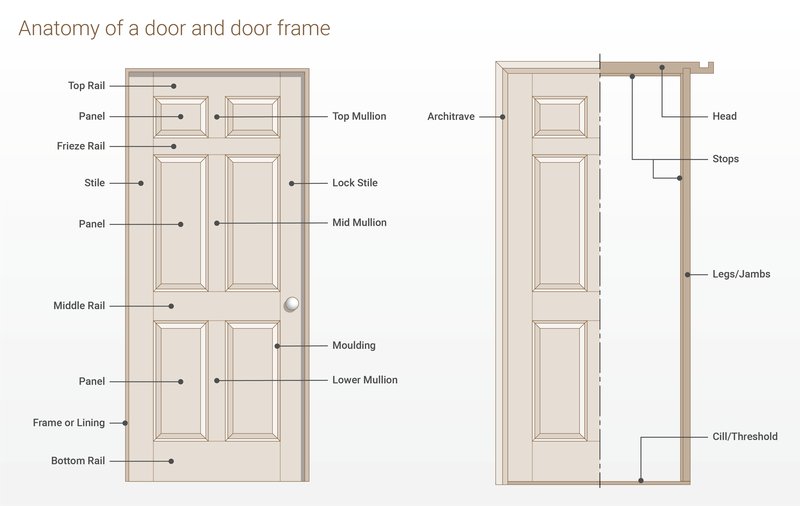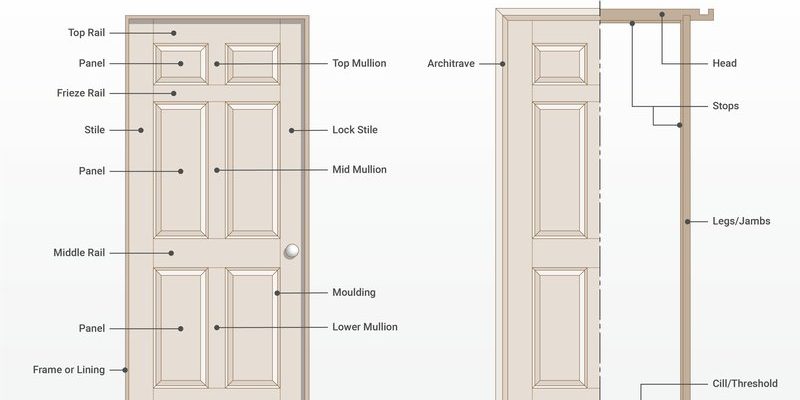
Door jambs are more than just wooden frames; they provide support for the door hardware, such as hinges and locks. This means they help ensure your door opens and closes smoothly, keeping your home secure. Whether you’re working with a new door installation or troubleshooting an old one, understanding door jambs can save you a lot of headaches.
Let’s dive deeper into the world of door jambs and explore their essential role in the overall function of door hardware. Knowing what they are and how they work can make a difference in your home maintenance and improvements.
What Is a Door Jamb?
A door jamb is essentially the vertical part of a door frame. It consists of two sides: the lock side and the hinge side. These components support the door itself, allowing it to swing open and closed. You might think of a door jamb as the strong, silent hero of your door setup. It quietly does its job while you focus on the more visible elements, like the door’s color or style.
The jamb typically includes the jamb legs (the vertical pieces) and the jamb head (the top piece). These components work together to provide a secure fit for the door. If you’ve ever watched a door close, you might have noticed how it fits snugly against the jamb. That snug fit is what keeps out drafts and ensures safety.
Why Does a Door Jamb Matter?
Without a properly installed door jamb, your door might not function as it should. It could sag, stick, or even not latch properly. Basically, a door jamb is crucial for ensuring that your door operates smoothly. If you think about it, the door doesn’t just hang there on its hinges; it relies on the jamb to provide support and alignment.
Types of Door Jambs
There are different types of door jambs, including pre-hung, flush, and split jambs. Each type has its unique applications and benefits, so understanding the differences can help you choose the right one for your needs.
- Pre-hung Jambs: These are built-in units that come with the door already attached. They make installation easy because everything is already aligned. Perfect for DIYers!
- Flush Jambs: These are flat and used mainly for modern, minimalist designs. They provide a clean look and can be more visually appealing in certain settings.
- Split Jambs: These are often used in remodeling projects. They allow for easy installation over existing frames without the need for extensive repairs.
When selecting a door jamb, consider your specific situation. Do you want an easy, no-fuss installation with a pre-hung jamb, or are you looking for a sleek design? The type you choose can impact not only how your door looks but also how well it performs.
How Door Jambs Work with Door Hardware
Now that you have a grasp on what door jambs are and the different types available, let’s talk about how they work with hardware. Each door relies on hardware like hinges, locks, and strike plates to function correctly. The door jamb acts as the anchor point for all this hardware.
For instance, hinges are typically mounted on the hinge side of the door jamb. This is crucial because the way they’re installed affects how well the door swings in and out. If the jamb is misaligned, the door might not open evenly—or may even stick.
Locks, too, depend on a well-fitted jamb. The strike plate is set into the door jamb, allowing the lock to engage smoothly. If the jamb is damaged or warped, it can misalign the lock, making it hard to secure the door. So, keeping your door jamb in good condition is essential for your home’s security.
Common Problems with Door Jambs
While door jambs are pretty solid, they can run into issues just like anything else. Here are some common problems you might encounter:
- Warping: Changes in humidity can cause wood to warp, making doors hard to open or close.
- Damage: Impacts or moisture can lead to cracks or rot, which compromise the jamb’s structural integrity.
- Misalignment: If the door is not hanging straight, you may need to adjust the jamb to restore proper function.
If you notice any of these issues, don’t panic! Many problems can be fixed with a little effort. For example, adjusting the hinges can often remedy misalignment issues. If it’s warping, sometimes simply adding a coat of paint can help seal and protect it.
How to Maintain Your Door Jamb
Keeping your door jamb in good shape doesn’t require extensive effort. Here are some simple maintenance tips that can help extend the life of your jamb:
- Regular Inspections: Every few months, check the jamb for any signs of wear or damage. Look for cracks or warping and address them before they get worse.
- Seal the Wood: If your jamb is wood, applying a sealant can protect it from moisture, preventing rot and warping.
- Keep It Clean: Simply wiping the frame down regularly can prevent dirt buildup that could lead to deterioration over time.
By staying on top of these maintenance tasks, you can ensure your door jamb remains functional and attractive. This small effort can save you money and hassle in the long run.
Door jambs might not be the first thing you think about when it comes to home maintenance, but they play a vital role in ensuring your doors function properly. Understanding their types, how they work with door hardware, and how to maintain them can make a significant difference in your home security and comfort.
So, next time you walk through a door, take a moment to appreciate the jamb that helps keep it all together. A solid, well-maintained door jamb isn’t just a frame; it’s the unsung hero of your home!
